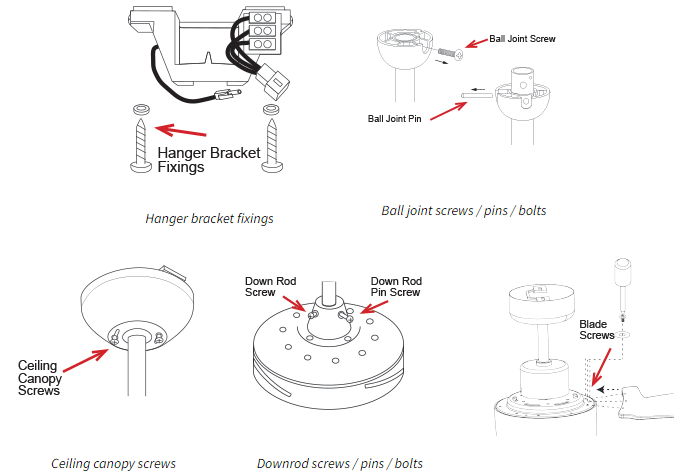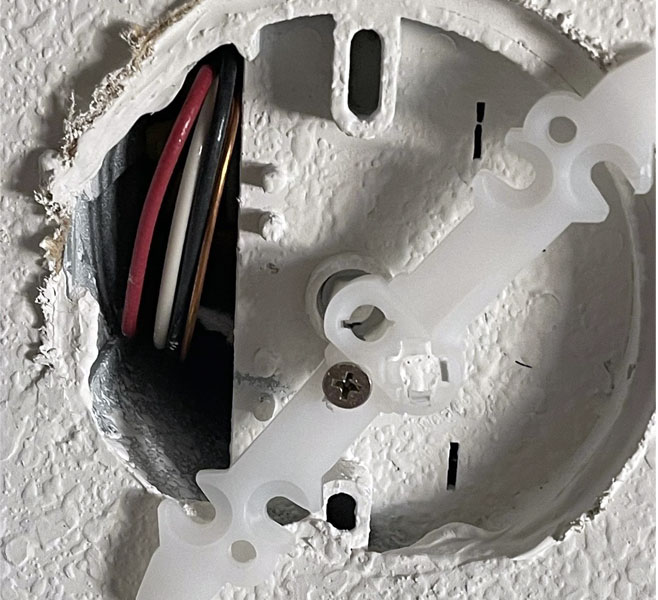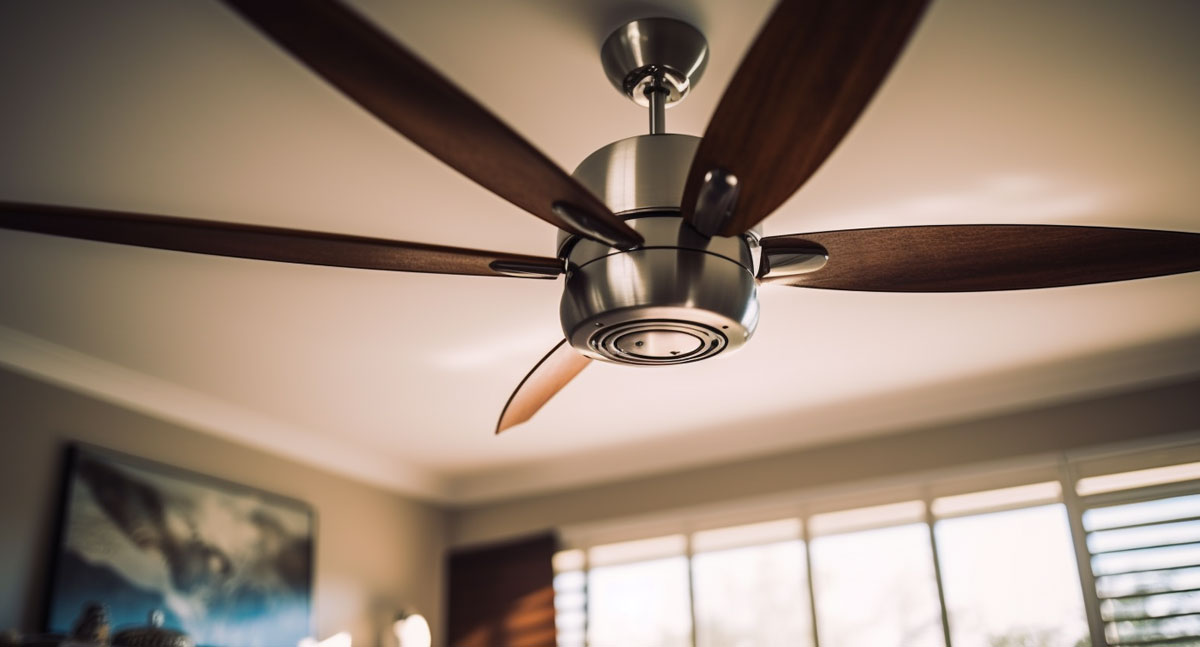Ceiling fans are essential components of any home, providing comfort and energy savings. However, a noisy ceiling fan can be a nuisance and detract from the comfort they’re meant to provide. Maybe it’s making a buzzing sound, or maybe it’s making a knocking sound, in this comprehensive guide, we will discuss the common causes of ceiling fan noise and provide detailed instructions on how to troubleshoot and fix these issues. Additionally, we’ll cover proper maintenance techniques to prevent future noise problems.
Why does my ceiling fan make noise?
Your ceiling fan makes noise for several reasons, you could have loose screws, the blades might be unbalanced, there could be motor issues, the blades might be dirty or the installation could have been poor, here we’ll discuss each possible cause and potential solutions.
Loose screws
Loose parts are among the most common causes of noise in ceiling fans. Over time, vibrations from the fan’s operation can cause screws, bolts, and other fasteners to loosen. These loose components can lead to a variety of noise issues, ranging from subtle rattling to more pronounced clanking sounds. Additionally, loose parts can cause the fan to wobble or shake, further exacerbating the noise problem.
Here is a breakdown of the key areas to inspect for loose parts:
- Blade brackets: These brackets secure the blades to the motor assembly. Ensure that the screws holding the blade brackets are tight, and also verify that the screws connecting the blades to the brackets are secure.
- Motor assembly: The motor assembly consists of various components that may become loose, including the motor housing and mounting brackets. Inspect the assembly for any loose screws or bolts, and tighten them as necessary.
- Downrod: The downrod connects the fan to the ceiling mounting bracket. A loose downrod can cause the fan to wobble and create noise. Ensure that the downrod is securely fastened to the motor assembly and the mounting bracket.
- Canopy: The canopy is the decorative cover that hides the wiring and mounting bracket. If the screws securing the canopy are loose, it may rattle against the ceiling. Tighten these screws to eliminate any noise from the canopy.
- Light fixture: If your ceiling fan has a light fixture, check the screws holding the fixture in place, as well as any connections between the fixture and the fan. Loose components can cause the light fixture to vibrate and produce noise.
One thing you can do to help keep your screws in place for longer is to use some Loctite® Threadlocker Blue 242.
The most common place where screws and/or bolts are not done up tightly or potentially loosen over time is the actual fan blade fixing screws. We recommend perform regular checks on these.


Unbalanced blades
Unbalanced blades are another common cause of noise in ceiling fans. When the blades are not properly balanced, they can create vibrations that result in noise during operation. In addition, unbalanced blades can cause the fan to wobble or shake, which may lead to further noise issues and even damage the fan’s motor or mounting components over time.
There are several factors that can contribute to unbalanced blades:
- Uneven weight distribution: If the weight distribution across the blades is uneven, it can cause the fan to become unbalanced. This may be due to manufacturing inconsistencies, warping over time, or damage to the blades.
- Misaligned blade brackets: If the blade brackets are misaligned or bent, they can cause the blades to sit at an improper angle, leading to imbalance.
- Dirt and debris accumulation: Dust and debris can accumulate on the fan blades, adding weight and disrupting the balance. Regular cleaning can help prevent this issue.
To diagnose and correct unbalanced blades, follow these steps:
- Inspect the blades: Examine the blades for any signs of damage, warping, or excessive dirt. Clean the blades thoroughly and replace any that are damaged.
- Check blade alignment: Turn off the fan and gently push each blade upward to ensure they are all level. If you notice any misaligned blades, adjust the blade brackets as necessary to achieve proper alignment.
- Use a blade balancing kit: If the issue persists, use a blade balancing kit, which typically includes a plastic clip and adhesive weights. Attach the clip to the trailing edge of a blade, and turn on the fan to observe any changes in wobble or noise. Move the clip to different blades until you identify the blade causing the imbalance. Then, apply the adhesive weights provided in the kit to the top side of the blade, close to the clip’s position, until the fan operates smoothly and quietly.
Motor issues
Motor issues can be a significant source of noise in ceiling fans, causing humming, buzzing, or whirring sounds. Understanding the potential causes and how to address them can help you resolve motor-related noise problems and extend the life of your ceiling fan.
Some common motor issues that may cause noise include:
- Worn or damaged motor windings: Over time, the motor windings can become worn or damaged due to constant use, leading to humming or buzzing sounds. If the noise is consistent and increases with the fan speed, it may be an indication of a winding issue.
- Loose or misaligned motor components: The motor assembly consists of various components, such as stator, rotor, and mounting brackets. If any of these components become loose or misaligned, they can cause vibrations and noise.
- Capacitor issues: The capacitor is responsible for providing the initial torque to start the motor and maintain its speed. A malfunctioning capacitor can cause the motor to struggle, resulting in humming or buzzing sounds.
To diagnose and address motor issues, follow these steps:
- Listen closely: Turn on the fan and carefully listen to the motor while it is running. If you hear a consistent humming or buzzing sound that increases with the fan speed, it may indicate a problem with the motor windings or capacitor.
- Inspect the motor assembly: Turn off the fan and carefully inspect the motor assembly for any loose or misaligned components. Tighten any loose parts and ensure that all components are properly aligned.
- Test the capacitor: If you suspect a capacitor issue, consult a professional electrician or ceiling fan technician to test the capacitor and replace it if necessary.
- Seek professional assistance: If you are unable to resolve the motor issue on your own, or if you are unsure about the cause of the noise, consult a professional electrician or ceiling fan technician for assistance. They can diagnose and repair motor problems to ensure the optimal performance and longevity of your ceiling fan.
Dirty or Damaged Bearings
Dirty or damaged bearings are another common cause of noise in ceiling fans. When the bearings become dirty, they can generate friction, leading to squeaking or grinding sounds. Damaged bearings can exacerbate this issue, creating even louder and more persistent noise.
Here’s a closer look at the factors contributing to dirty or damaged bearings and how to address them:
- Dust and debris accumulation: Over time, dust and debris can accumulate on the bearings, increasing friction and causing noise. Regular cleaning can help prevent this buildup and ensure smooth operation.
- Lack of lubrication: Bearings require proper lubrication to reduce friction and wear. Insufficient lubrication can lead to increased noise and eventual damage to the bearings.
- Normal wear and tear: Bearings are subject to wear and tear due to the constant motion of the fan. Over time, this wear can lead to damage and increased noise.
To diagnose and resolve issues with dirty or damaged bearings, follow these steps:
- Clean the bearings: Turn off the fan and carefully remove it from the ceiling. Disassemble the motor housing to access the bearings. Use a soft cloth or brush to clean the bearings, removing any dust and debris.
- Lubricate the bearings: After cleaning the bearings, apply a small amount of lubricant specifically designed for ceiling fan bearings. This will help reduce friction and extend the life of the bearings. Avoid using too much lubricant, as this can attract dirt and cause the bearings to become dirty again.
- Inspect for damage: While cleaning and lubricating the bearings, inspect them for signs of damage, such as pitting, scoring, or excessive wear. If the bearings appear damaged, consider replacing them.
- Replace damaged bearings: If you determine that the bearings are damaged and need replacement, consult a professional electrician or ceiling fan technician for assistance. Replacing bearings can be a complex task that requires specific tools and expertise.
Poor Installation
Poor installation can significantly contribute to noise issues in ceiling fans. Improper installation can result in various noise problems, such as rattling, humming, or vibrating sounds. Ensuring that your ceiling fan is correctly installed is crucial for optimal performance, longevity, and quiet operation.
Some common installation issues that can cause noise include:
- Insecure mounting: If the ceiling fan is not securely mounted to the ceiling or the mounting bracket, it can wobble, vibrate, or rattle, leading to noise.
- Improper electrical connections: Loose or incorrect electrical connections can cause humming or buzzing sounds. Ensuring that all electrical connections are secure and properly installed is essential for quiet operation.
- Incorrect blade height: If the blades are installed at inconsistent heights, the fan can become unbalanced, resulting in vibration and noise.
- Using the wrong mounting system: Ceiling fans require specific mounting systems depending on the ceiling type and height. Using an incompatible mounting system can lead to noise issues and potential damage to the fan.
- The fan is installed too low: Having your fan installed too low from the ceiling can create excessive vibration.
To diagnose and correct poor installation, follow these steps:
- Check the mounting: Inspect the ceiling fan’s mounting bracket and ensure that it is securely fastened to the ceiling and the fan’s motor assembly. Tighten any loose screws or bolts as needed.
- Inspect electrical connections: Turn off power to the fan and verify that all electrical connections are secure and properly installed. If you’re unsure about the electrical connections, consult a professional electrician like Finnley Electrical who specialises in new ceiling fan installations.
- Ensure consistent blade height: Examine the fan blades and confirm that they are installed at the same height. Adjust the blade brackets as needed to achieve consistent blade height.
- Verify the mounting system: Ensure that the mounting system used for your ceiling fan is compatible with your ceiling type and height. If necessary, consult the fan’s installation manual or contact the manufacturer for guidance.
How do I stop my ceiling fan from making a knocking sound?
The best way to stop your ceiling fan from making a knocking sound is to tighten all of the screws. This includes the screws that hold the blades in place, as well as the screws that hold the motor in place. If you’re not sure how to do this, please consult your ceiling fan’s manual or contact the manufacturer; alternatively, an electrician from Finnley Electrical can attend your home or business and either tighten the screws or perform a ceiling fan installation to replace your damaged unit.
In addition to tightening the screws, you should also check the ceiling fan blades and motor for any damage. If you see any cracks or damage, please replace the damaged parts as soon as possible.
Lastly, you may want to purchase a ceiling fan balancing kit, these are usually fairly affordable and easy to install.
How to Stop a Ceiling Fan from Making Noise
Follow these steps to diagnose and resolve the most common causes of a noisy ceiling fan:
Step 1: Tighten Loose Parts
Inspect the ceiling fan for loose screws, blade brackets, or other components. Use a screwdriver to tighten any loose parts securely.
Step 2: Check for Unbalanced Blades
To test for unbalanced blades, turn off the fan and gently push each blade upward to see if it’s level. If one or more blades are uneven, you can use a blade balancing kit to correct the issue.
Step 3: Inspect the Motor
Listen closely to the motor while the fan is running. If you hear a humming or buzzing sound, there may be a problem with the motor. In this case, consult a professional electrician or ceiling fan technician.
Step 4: Clean or Replace Bearings
If you hear grinding or squeaking noises, the bearings may be dirty or damaged. To clean them, remove the fan from the ceiling, disassemble the motor housing, and use a cloth or brush to clean the bearings. If the bearings are damaged, consider replacing them.
Step 5: Ensure Proper Installation
Ensure that the fan is securely mounted to the ceiling and that all electrical connections are properly installed. If you’re unsure about the installation, consult a professional electrician.
Proper Maintenance to Prevent Future Noise Issues
To keep your ceiling fan running smoothly and quietly, follow these maintenance tips:
- Regularly tighten screws and other components: Check for loose parts periodically and tighten them as necessary.
- Clean fan blades and motor: Remove dust and debris from the fan blades and motor housing to prevent buildup that can cause noise and reduce efficiency.
- Lubricate bearings: Apply a small amount of lubricant to the bearings annually to ensure smooth operation and minimize friction.
- Inspect for wear and tear: Regularly check for signs of damage or wear on the fan blades, motor, and other components. Address any issues promptly to prevent further damage and noise problems.
- Balance blades: Routinely check the balance of the fan blades and adjust them as needed to maintain optimal performance and minimise vibration.


